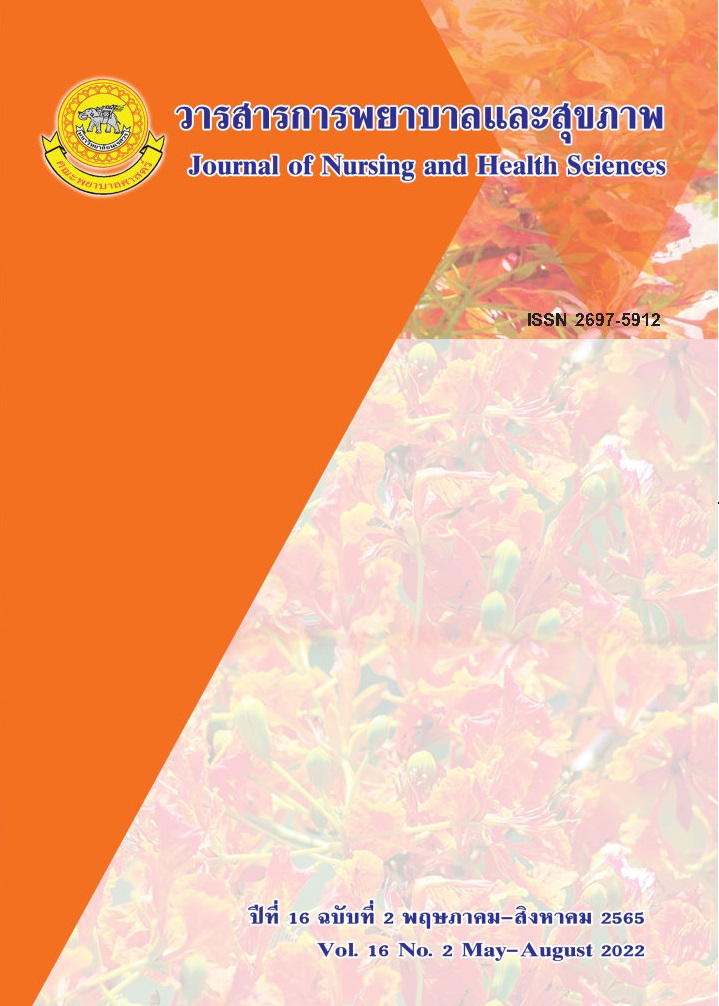Predicting Factors of Health Literacy in Patients with Type 2 Diabetes Mellitus, Uttaradit Province
Main Article Content
Abstract
The purpose of this predictive correlational research study was to study factors predicting health literacy
among patients with type 2 diabetes mellitus, in Uttaradit Province. There were 200 patients with type 2
diabetes mellitus participating in the study, aged 30 years and older, who were selected by multi-stage random
sampling. The research instruments used, showing the reliability of Cronbach's alpha coefficient, included
a perception of health status questionnaire (0.87), a social support questionnaire (0.91), an effective
communication questionnaire (0.92), and a health literacy questionnaire (0.96), and they had all been tested
for content validity with a score of 0.90. The data were analyzed by descriptive statistics and enter regression
analysis.
The results revealed that health literacy was at a moderate level ( = 104.12, S.D. = 19.50). Perception
of health status, social support and effective communication were found as good combine predictions of health
literacy among the patients, with 59.1% of variance (R2 = .591, p < .001).
These results suggest thatcommunity nurse practitioner should concern effective communicationand
social support in order to promote better awareness of health behavior and to enhance health literacy among
patients with type 2 diabetes mellitus
Article Details

This work is licensed under a Creative Commons Attribution-NonCommercial-NoDerivatives 4.0 International License.
References
Aekplakorn, W. (2021). The 6th national health
examination survey, 2019-2020. Bangkok: Aksorn
graphic and design. [In Thai].
Baker, D. W., Gazmararian, J. A., Williams, M.V., Scott,
T., Parker, R. M., Green, D., …Peel, J. (2002).
Functional healthliteracy and the risk of
hospital admission among medicare managed
care enrollees. American Journal of Public
Health, 92(8), 1278-1283.
Berkman, N. D., Sheridan, S. L., Donahue, K. E., Halpern,
D. J., Viera, A., Crotty, K., … Viswanathan,
M. (2011). Health literacy interventions and
outcomes: an updated systematic review. RTI
International-University of North Carolina
Evidence-based Practice Center Research
Triangle Park, North Carolina, AHRQ Publication.
Best, J. W. (1977). Research in education (3rd ed.).
Englewood Cliffs, New Jersey: Prentice Hall.
Brook, R. H., Ware, J. E., Davies-Avery, A., Stewart,
A. L., Donald, C. A., Rogers, W. H.,… Johnston,
S. A. (1979). Overview of adult health status
measures field, Medical Care, 17, 7.
Chantha, W. (2016). Health literacy of self-care
behaviors for blood glucose control in
patients with type 2 diabetes, Chainat province.
Bangkok: Mahidol University. [In Thai].
Chiangkhong, A. (2018). Effectiveness of development of
health literacy through controlled transformative
learning due to glycemic control behavior among
diabetic patients. Bangkok: Srinakharinwirot
University. [In Thai].
Department of Disease Control, Division of noncommunicable disease. (2019). Annual report
Retrieved 24 December 2019 from http://
www.thaincd.com/2016/media-detail.php?
id=13800&tid=&gid=1-015-005
House, J. S. (1981). Work, stress and social support.
Reading, MA: Addison Wesley.
Intarakamhang, U. (2017). Health literacy: Measurement
and development. Bangkok:Sukhumvit Printing
Co. [In Thai].
International Diabetes Federation. (2019). Diabetes
atlas. Retrieved 10A pril 2018 from https://
www.diabetesatlas.org/
Kaeodumkoeng, K. (2018). Health literacy: access,
understand and application. Bangkok: Amarin.
[In Thai]
Kaewtong, N., Termsirikulchai, L., Leelaphun, P.,
Kengganpanich, T., & Kaeodumkoeng, K. (2014).
Health literacy of group at risk of hypertension at
Ban Nonghoi Sub-District Health Promoting
Hospital, Sa Kaeo Province. Journal of
Boromarajonani College of Nursing, Bangkok,
(1), 45-56. [In Thai].
Khumthong, T., Potisiri, W. & Kaeodumkoeng, K.
(2016). Factors influencing health literacy for
people at risk of diabetes mellitus and hypertension
ofUthaiThani and Ang Thong. Veridian EJournal Science and Technology Silpakorn
University, 3(6),67-85. [In Thai]
Liu, Y. B., Hou, P., Xue, H. P., Mao, X. E., & Li, Y. N.
(2019). Social support health literacy, and health
care utilization among older adults. Asia Pacific
Journal of Public health, 31(4), 359-366.
Madican, K., Oba, N., Supametaporn, P. (2020).
Factors related to health literacy in patients
with uncontrolled type 2 diabetes. Journal of
Nursing and Health Sciences, 14(1), 1-15. [In Thai]
Osborne, R. H., Batterham, R. W., Elsworth, G. R.,
Hawkins, M., & Buchbinder, R. (2013).
The grounded psychometric development
and initial validation of the health literacy
questionnaire (HLQ). BMC Public Health, 13:658,
-17.
Pender, N.J. (1987). Health promotion in nursing practice
(2nd ed). New York: Appleton Century Crofts.
Phetarvut, S., Watthayu, N., &Suwonnaroop, N. (2011).
Factors predicting diabetes self-management
behavior among patients with diabetes mellitus
type 2. Nursing Science Journal of Thailand,
(4), 18-26. [In Thai].
Sayah, A. F., Majumdar, S. R., Wiliams, B., Robertson,
S., & Johnson, J. A. (2013). Health literacy and
health outcomes in diabetes: a systematic review.
Journal of General Internal Medicine, 28(3),
-452.
Schillinger, D., Grumbach, K., Piette, J., Wang, F.,
Osmond, D., Daher, C., …Bindman, A. B. (2002).
Association of health literacy with diabetes
outcomes. JAMA, 288(4), 475-482.
Stolar, M. (2010). Glycemic control and complications in
type 2 diabetes mellitus. American Journal of
Medicine, 123(3), S3-S11.
Suphunnakul, P. (2020). Applied statistics in public
health research (2nd ed). Phitsanulok: Naresuan
University Publishing House. [In Thai].
Thummaphol, P. (2016). Health literacy and clinical
outcomes in people with hypertension,
dyslipidemia and type 2 diabetes mellitus.
Journal of Nursing and Health Care, 34(3),
-182. [In Thai].
Toci, E., Burazeri, G., Jerliu, N., Sorensen, K., Ramadani,
N., Hysa, B., … Brand, H. (2014). Health literacy,
self-perceived health and self-reported chronic
morbidity among older people in Kosovo.
Health Promotion International, 30(3), 667-674.
Uttaradit Provincial Public Health Office. (2019).
Morbidity rate of diabetes at health region 2
Uttaradit province. Retrieved 15 December 2019
from https://utt.hdc.moph.go.th/hdc/reports/
report.php?source=formated/ncd.php&cat_id
=6a1fdf282fd28180eed7d1cfe0155e11&id=cefa
b9223ec4d 1969c5ce18d762bdd. [In Thai]


